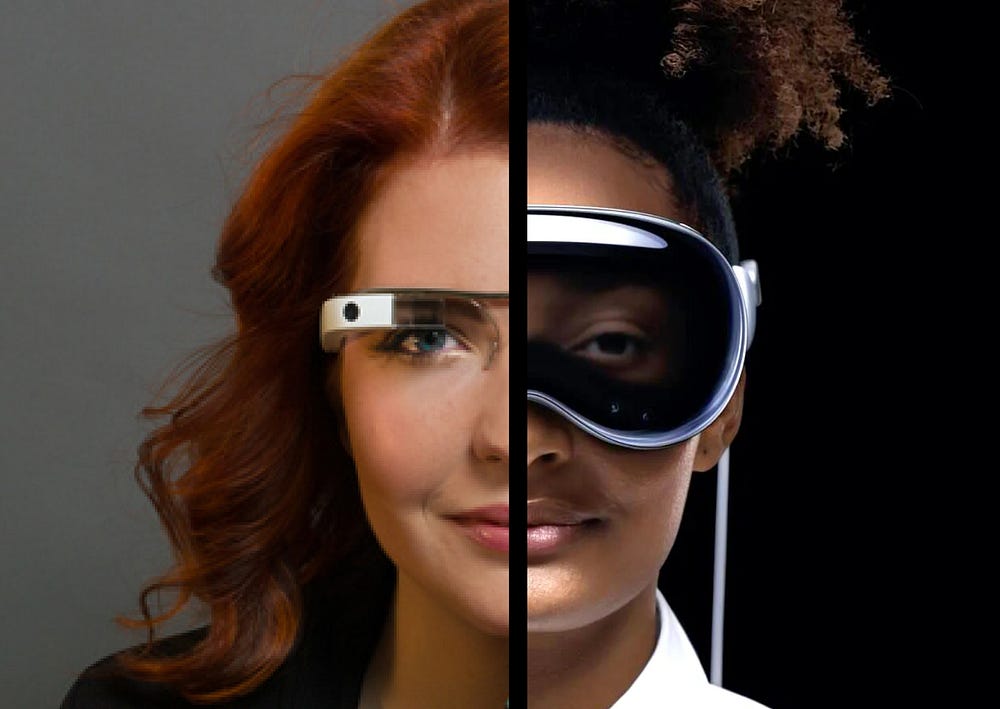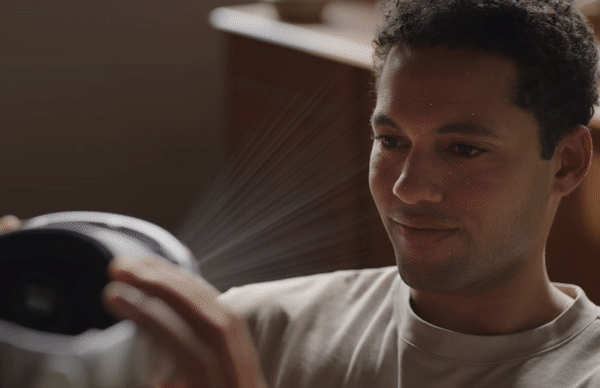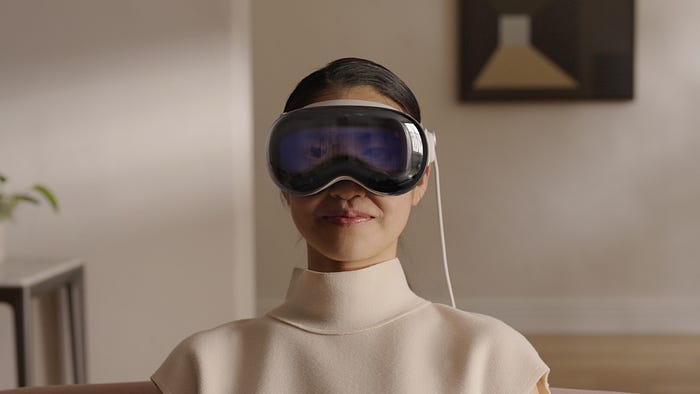

Can Apple’s Vision Pro succeed where Google Glass failed?
source link: https://uxdesign.cc/can-apples-vision-pro-succeed-where-google-glass-failed-b186898989cf
Go to the source link to view the article. You can view the picture content, updated content and better typesetting reading experience. If the link is broken, please click the button below to view the snapshot at that time.
Can Apple’s Vision Pro succeed where Google Glass failed?
Google Glass failed for a few reasons: no clear purpose of use, safety concerns, price, & more. Will Apple’s Vision Pro face the same fate?

Do you remember Google Glass? You know, the glasses with a built in android device that can be controlled by voice and motion controls.
Well, if you don’t know, it’s because it was a huge failure.
Google Glass emerged as a highly anticipated innovation with the potential to revolutionize our daily lives. Its sleek design, hands-free interface, and augmented reality (AR) capabilities promised a futuristic experience.
However, despite its initial hype and grand vision, Google Glass ultimately failed to capture the consumer market and find widespread adoption.
Google Glass failed for several reasons: no clear purpose of use, safety concerns, no existing market, price, and more.
With the recent release of Apple’s Vision Pro, I can’t help but wonder if this AR headset will head down the same path.
Every LinkedIn post and article I’ve seen on Apple’s new product is being overloaded with negative comments, some with the same concerns people had when Google Glass was released.
Let’s dive a bit into why Google Glass failed to see if we can make a prediction.
High cost, low reward
One of the major hurdles that hindered the success of Google Glass was its high price tag. At its launch in 2013, the Explorer Edition of Google Glass was priced at $1500, making it inaccessible to the average consumer. With Apple’s Vision Pro being $3500, this kind of technology won’t become mainstream anytime soon.
In addition to the hefty price tag, Google Glass struggled to showcase compelling use cases that would justify it. The device aimed to solve problems that people didn’t have. Need to check the weather or find directions? Just take out your smartphone.
On top of this, the battery life wasn’t good. The device lasts around 4 hours, though it was advertised by Google to last a typical day. However, while shooting a video, the battery is reported to only last for 30 minutes!
Users struggled to find everyday value in wearing the device.
Apple seems to be combating this issue by marketing the Vision Pro as more of an entertainment and at-home device. They show the device being used as a private movie theater, an epic gaming screen, and a new way to work from home. In addition, they reveal a small and powerful charger that can fit right in your pocket.
Apple Vision Pro release videoAt the end of the day, this is a niche market. We can already accomplish many of the things that Apple advertised with the devices we currently own, albeit a difference experience overall.
Sure, having a private movie theater on your head might be cool, but most people already have TVs. In addition, if you want to watch TV with friends or family, you can’t use your headset. (Unless of course, you and your buddies all want to whip out your $3500 headsets and sync them up.)
I can browse the internet from my phone, computer, or tablet already. Why do I need another device?
At the end of the day this is a product that is wanted, not needed.
It’s a luxury device for people who have the extra money, rather than something like a smartphone that has become a necessity of this world.
Apple didn’t need to convince people that they needed a phone. When iPhones came out, they simply created a great product to fill an existing market.
With an AR headset, however, people need to be convinced of it’s value.
While any future iterations of AR headsets might not be as ubiquitous as smartphones, that doesn’t mean it will be a failure. Only time will tell!
Safety & Privacy Concerns
Safety and privacy concerns were present on both sides of the glass. Sure, the wearer has their location and voice being tracked, but what about who the glasses were pointed at? Usually if someone is recording you, they need to physically hold up a large device like a phone or a camera. With a simple pair of glasses, there is no way to know if someone is recording or taking photos of you.
“Google Glass with its constant monitoring of your location and the presence of camera meant that it could be recording or taking photos at any time without users even realizing it. Due to this, the product was banned at many locations including theatres, casinos and medical centres, where it could be used to record stuff illegally.” — Feedough
People were uneasy about the possibility of being recorded without their consent, which resulted in the term “Glasshole” for wearers of the device. The lack of social acceptance further hindered the adoption of Google Glass, as it became associated with intrusive behavior rather than technological innovation.
The reality is, as time goes on we are being conditioned more and more to being okay with our data being stolen. Since 2013 when Google Glass was released, we have been introduced to Amazon’s Alexa, Google Home, Apple face ID, Snapchat face filters that scan and track your face, and more.
With current technology, our voices can be copied and deepfakes are popping up all over the internet.
They already have our voices, faces, fingerprints, location data, search data, and probably more. All of our 2D data is already theirs, now all they need is our 3D data.
If you’ve watched the release video for the Apple Vision Pro, you may have noticed that using FaceTime is a prominent feature displayed. Well, how do the people on FaceTime see you without a camera?
The headset takes hyper-realistic 3D scans of your face to create a virtual avatar that speaks and tracks your face and hand movements in real time.

Deepfakes based on photos and videos are already getting scarily realistic, so imagine what our 3D data could be used for.
It’s scary to think about it this way, but it’s the world right now. Slowly, we have been conditioned to get used to this kind of privacy invasion.
We were scared of Google Glass then, but have we been conditioned to accept the future of AR now?
I guess we will have to wait and see. Maybe if Apple’s headset fails now due to safety concerns, we will be accustomed to the idea in a decade or so.
Apologies if this section is freaking you out. I know it’s freaking me out!
Timing and Market Readiness
Google Glass seemed to be ahead of it’s time.
While the concept was new and innovative, the technology and infrastructure required to support its full potential were not mature enough. The limited battery life, underwhelming performance, and the absence of widespread high-speed internet connectivity hindered the seamless user experience Google Glass seemed to envision.
In short, we weren’t ready for it yet. As mentioned above, people weren’t used to this high level of privacy invasion and constant immersion in the tech world.
We still might not be ready.
If the Vision Pro fails now, I’m sure another AR headset will popup in a few (or several) years from now that will take the world by storm.
Design & Social Acceptance
While Google Glass featured an innovative concept, its design and aesthetic failed to resonate with mainstream consumers.
The device looked more like a weird piece of technology rather than a fashionable accessory. The bulky touch pad on the right side of the glasses made wearers stand out and feel self-conscious.

At the end of the day, people were embarrassed to wear Google Glass out in public.
In addition to that, “wearing it in a dark alley or even in a crowded place doesn’t really sound too safe; given its price.”
Comparing the sleek and minimal design of Google Glass to the large, clunky, screen-for-eyes headset that the Vision Pro has, it’s safe to assume that this will be a product users keep at home.

I don’t think we will be seeing people walking around the mall with one of these things on.
The difference is that Apple’s product seems to be marketed for home use. In the release video for the Vision Pro, the product is almost exclusively used at home, besides the clip of a woman watching a movie on an airplane.
It’s showcased as a new way to experience entertainment and the web at home.
Google Glass, however, was marketed as tech on the go.
Google Glass official concept videoWear it around town, open up the map to find where you need to go, set up reminders, locate your friends, check in to a food place, etc.
This was a product made for wearing while out and about, which was unwanted by people on both sides of the glasses.
Reactions to the Apple Vision Pro
Reactions have been mixed, to say the least.
Some people believe this AR future will lead to even more social isolation and technology reliance. They believe we are online enough, we don’t need it to be attached to our heads.
Others have concerns for the future. For example, how will this affect the younger generation? It could result in their real-life identities being replaced by digital identities. There are already plenty of problems stemming from smartphones and social media.
If the device is constantly scanning you, does it scan your body too? What about when you go to the bathroom? Is it saving all of this data? Is it creating a digital map of my house? What if the data is leaked?
It’s way too expensive and doesn’t do anything remarkably different from what existing devices can do.
It’s not all negative, however. Some people are excited about the new innovation and are excited for the future of the product down the line.
Many seem to think that this is the start of an AR revolution and AR/VR are the future.
I’m not going to lie, I think it seems pretty cool. I’d love to open up a video game or a movie in this thing just to see what it’s like. While I’d love to try it out, there is NO way I’d pay $3500. I wouldn’t even pay $400. That being said, the idea is there and I’m on board. (Minus the weird face scanning stuff).
While the product is expensive now, it’s only the first iteration. The product will only get smaller and cheaper as time goes on. The current headset might not be a success, but it could be setting up a successful future.
The social conditioning has to start somewhere, right?
Further Reading
- 5 Reasons Why Google Glass was a Miserable Failure →
The title says it all. - Fans React to Apple Vision Pro Announcement →
Some funny memes and reactions to Apple’s announcement. I got a good chuckle out of some of these. - Opinion: Why AR is the future despite Apple Vision Pro backlash, and one thing Google Glass did right →
Talks about how AR is the future and how Google Glass was on the right track. - The Real Reason Google Glass Failed Spectacularly →
How price, battery issues, and functionality led to the downfall of Google Glass.
Recommend
About Joyk
Aggregate valuable and interesting links.
Joyk means Joy of geeK